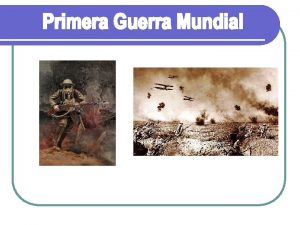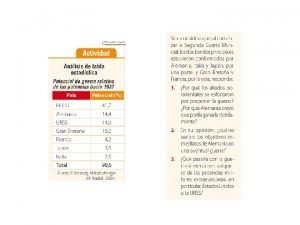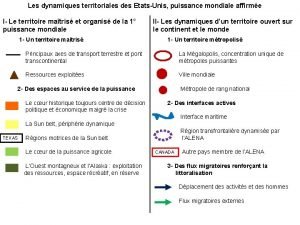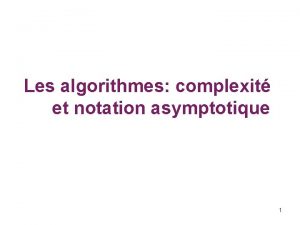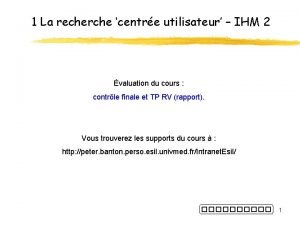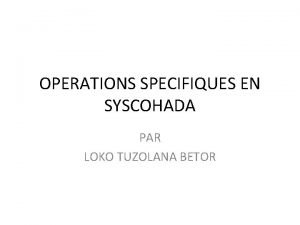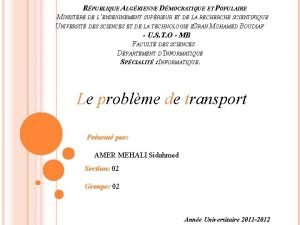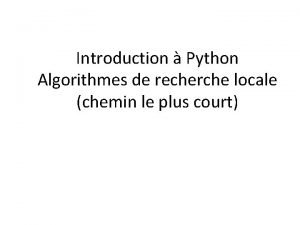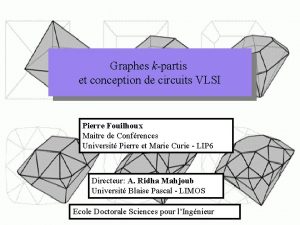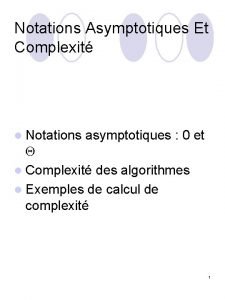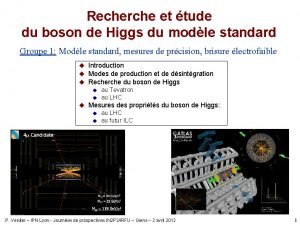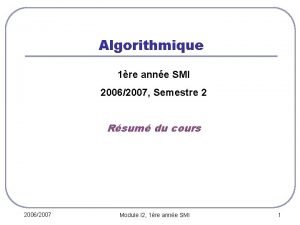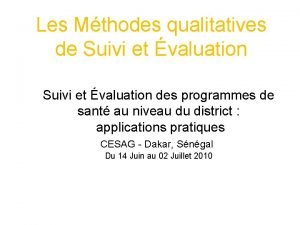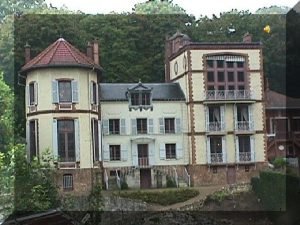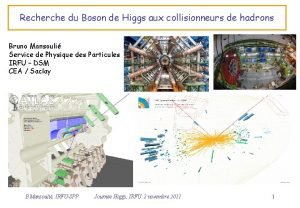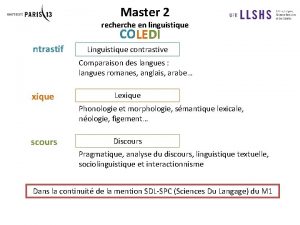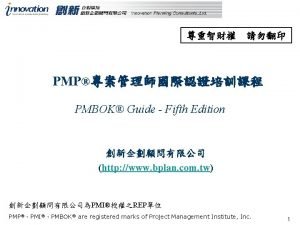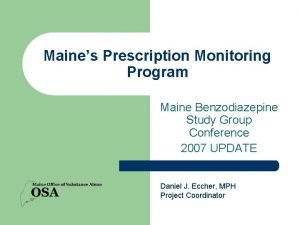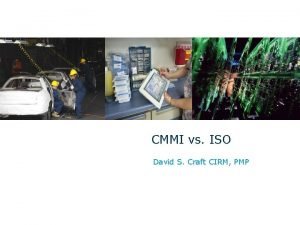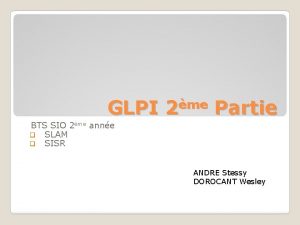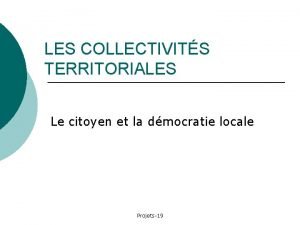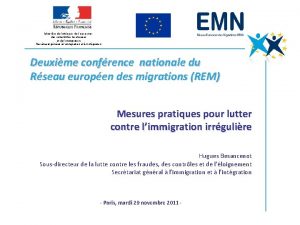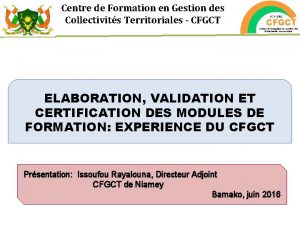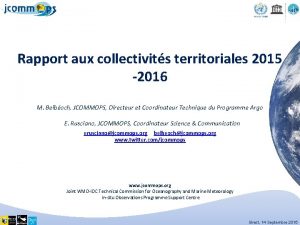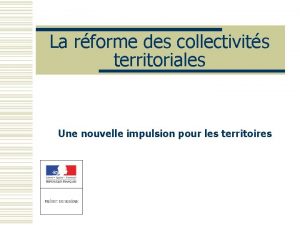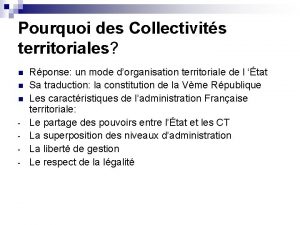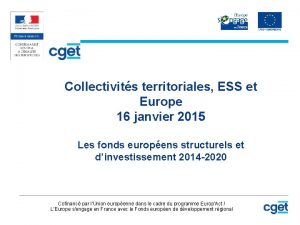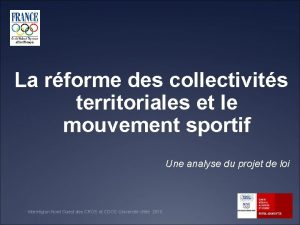Sminaire de recherche pmp 2me anne Collectivits territoriales





































































- Slides: 69

Séminaire de recherche (pmp 2ème année) Collectivités territoriales – institutions et politiques Andreas Ladner Master pmp automne 2015

«Idée du cours» ≠ Course in methodology and research design Attempt to write a scientific paper Learning by doing Understanding by applying | Diapositive 2 |

Simple questions – simple answers? • What is a variable? • Why hypotheses? • Why theory? | Diapositive 3 |

http: //moodle 2. unil. ch/course/view. php? id=4814 | Diapositive 4 |

Plan du cours 1. Research Methods and Design 2. Field and Data 3. Statistical Tools 4. Basics about Swiss Municipalities 5. Example Deliveries (présentation, travail de séminaire)

From Ontology to Techniques (-> Prof. Benoît Rihoux) • Ontological level (conceptions of the nature of things) • Epistemological level (conception of science) • Methodological level (research approach and methods) • Technical level – different techniques within a methodological approach | Diapositive 6 |

Ontological level • A discourse about the nature of things. Contains fundamental assumptions which have to be accepted. It is a general orientation about the world • Different competing ontological discourses are religious, scientific or philosophical/normative | Diapositive 7 |

Epistemological level • Conception of science and its goals, role of the scientist • Different epistemological positions are: – – – Positivism Post-positivism; realism Constructivism (radical/moderate) -> F Advocacy-driven, participatory Pragmatism | Diapositive 8 |

Source: B. Rhioux Differences | Diapositive 9 |

Methodological level Approaches/methods used: • Qualitative • Quantitative • Comparative • Mixed/integrated | Diapositive 10 |

Techniques Way to analyse or test something Interviews Analysis of Documents Surveys Secondary Data Analysis Experiments … | Diapositive 11 |

Drivers of research • Problem-driven research • Output-driven research • Theory-driven research • Method-driven research | Diapositive 12 |

Research Design (according to Rhioux) | Diapositive 13 |

Variables • Variables vary • Dependent and independent variables • Implied causality | Diapositive 14 |

Examples IV DV IV CV IV DV IV/CV DV IV ? | Diapositive 15 | DV

Hypotheses • Hypothesis = expected influence of (at least) one variable (IV) on a other variable (DV) • Can be tested (!) • Based on previous observations or theoretical expectations • Formulated ex-ante (!) | Diapositive 16 |

Theory • Theory = explanatory framework for observations • From theory follows a number of possible hypotheses that can be tested in order to provide support for, or challenge, theory. • General rules which help to understand society, institutions, individuals, etc. • Makes things more predictable | Diapositive 17 |

Comparative (advantages) for example: Political interest in Switzerland! ESS_2003_CH: Very interested: 14. 2; %, quite interested: 46. 4 %

European Social Survey 2002/03 Political interest

Remember: Research is … • Scientific (rational, objective) • Post-positivism, realism n ai M • (Quantitative (comparative)) | Diapositive 20 | !!! m • Explaining (and describing) ea str • Theory driven

Literature • Becker, H. S. (1998) Tricks of the trade: how to think about your research while you're doing it, Chicago: University of Chicago Press. • Creswell, J. W. (2009) Research design. Qualitative, quantitative and mixed methods approaches, 3 rd edn. London: Sage. • Moses, J. W. and Knutsen, T. L. (2007) Ways of knowing: competing methodologies in social and political research, New. York: Palgrave Macmillan. • Moses, J. , Rihoux, B. and Kittel, B. (2005) Mapping political methodology: reflections on a European perspective. European Political Science - EPS 4, 55 -68. | Diapositive 21 |

Plan du cours 1. Research Methods and Design 2. Field and Data 3. Statistical Tools 4. Basics about Swiss Municipalities 5. Example Deliveries (présentation, travail de séminaire)

Enquêtes auprès des secrétaires communaux (1988, 1994, 1998 et 2005, 2009) | Diapositive 23 |

Enquêtes: 1988, 1994, 1998, 2005, 2009 et 2016

• Soziologisches Institut der Universität Zürich • Mitarbeit: • Kompetenzzentrum für Public Management der Universität Bern (KPM) • Institut de hautes études en administration publique (IDHEAP)

Themen der Befragungen • 1988: Gemeindeschreiber 1: Politische Akteure, politische Systeme • 1994: Gemeindeschreiber 2: Leistungsgrenzen • 1998: Gemeindeschreiber 3: Gemeindereformen • 2005: Gemeindeschreiber 4: Gemeindereformen, Leistungsgrenzen, politische Systeme und Akteure • 2009: Gemeindeschreiber 5: Gemeindereformen, Leistungsgrenzen, politische Systeme und Akteure, Gemeindeversammlung • 2009: 1. Gesamtschweizerische Befragung der Exekutivmitglieder => http: //andreasladner. ch/gemeindeforschung/uebersicht. htm

http: //andreasladner. ch/gemeindeforschung/uebersicht. htm | Diapositive 27 |

| Diapositive 28 |

| Diapositive 29 |

| Diapositive 30 |

| Diapositive 31 |

Plan du cours 1. Research Methods and Design 2. Field and Data 3. Statistical Tools 4. Basics about Swiss Municipalities 5. Example Deliveries (présentation, travail de séminaire)

33 Titre de la présentation vendredi 11 février 2022

Main procedures • Descriptives • Frequencies • Crosstabs • Correlations • Regressions • Multi-level analyses • … | Diapositive 34 |

Plan du cours 1. Research Methods and Design 2. Field and Data 3. Statistical Tools 4. Basics about Swiss Municipalities 5. Example Deliveries (présentation, travail de séminaire)

Swiss municipalities - ideal laboratory for research N = 2324! | Diapositive 36 |

Characteristics w Origin of municipalities between the 14 th and 19 th century w 1874: All citizens have the same rights in all municipalities w 1998: First mentioning of municipalities in the Swiss Constitution (Art. 50) w Public bodies appointed by the public law of the cantons w Largely autonomous: municipalities can choose an appropriate structure, levy taxes, and independently perform tasks

Size of municipalities (%)

Size and canton

Different numbers of municipalities per Canton

Social, socio-economic, political and cultural characteristics • rural – urban • economic structure • language • confession • financial resources • political system • parties and party preferences • …. Often used as independent variables! | Diapositive 41 |

Possible characteristics of interest (dependent variables) • Political Participation • Existence of political parties • Representation of women • Difficulties to find candidates • Size of the local administration • Autonomy • New Public Management reforms • Amalgamation • …. | Diapositive 42 |

Plan du cours 1. Research Methods and Design 2. Field and Data 3. Statistical Tools 4. Basics about Swiss Municipalities 5. Example Deliveries (présentation, travail de séminaire)

Ideal structure of a paper • Introduction: research question/problem/puzzle, why this paper? (with respect to the public it addresses) • Theory and results from other studies • What we want to find out/test, hypotheses • Data, specific characteristics of the context, operationalization and measurement of the variables • Analyses, results • Conclusion: importance, reach and limits of the results, implications for further studies (So what? ) | Diapositive 44 |

How did the Swiss municipalities react to the financial and economic crisis? | Diapositive 45 |

Introduction • Research question: How did Swiss municipalities react? • Important question: Different strategies • Good setting to answer this question: Descretion and autonomy • Relevant for theory and policy makers | Diapositive 46 |

Theory ? • Austerity • Deficit spending (Keneys) | Diapositive 47 |

Empirical Evidence so far? | Diapositive 48 |

Research Questions • Impact of size and on the perception of the crisis • Smaller municipalities are less likely to use countercyclical measures • Size, affectedness, policy learning and culture affect the reaction | Diapositive 49 |

Not too much affected but larger municipalities are more affected | Diapositive 50 |

Larger municipalities react more often | Diapositive 51 |

Actions taken | Diapositive 52 |

Explaining the reaction | Diapositive 53 |

Explaining deficit spending | Diapositive 54 |

Explaining Austerity Policy | Diapositive 55 |

Conclusion ? | Diapositive 56 |

| Diapositive 57 |

Plan du cours 1. Research Methods and Design 2. Field and Data 3. Statistical Tools 4. Basics about Swiss Municipalities 5. Example Deliveries (présentation, travail de séminaire)

Scientific journals • Rankings • Citations • Jobs | Diapositive 59 |

http: //www. scimagojr. com/journalrank. php | Diapositive 60 |

Top journals «Social Science» | Diapositive 61 |

Top journals «Public Administration» | Diapositive 62 |

| Diapositive 63 |

Publish or Perish | Diapositive 64 |

| Diapositive 65 |

Different sources – different results Restricted access • Web of Science (by Thomson Reuters) and • Scopus (by Elsevier) Free access • eigenfactor, Cite. Seer, Research Papers in Economics or Citebase. | Diapositive 66 |

Deliveries Scientific paper (not more than 6000 words) containing: A: Research question B: Theoretical arguments C: Results D: Discussion of the results Presentation (10 – 12 minutes) | Diapositive 67 |

Travail de séminaire (en groupe) Define an comparative analytical framework using different characteristics of the territory (municipalities) as independent variables. Variables to be explained: quality of democracy, institutional settings, economic performance, policies, etc. | Diapositive 68 |

For next lesson • Field of interest • Research question • Dependent variable • Independent variables | Diapositive 69 |
 Wifi-2me
Wifi-2me 2me mains
2me mains Esquema de conflictos territoriales
Esquema de conflictos territoriales Contraofensiva aliada en europa
Contraofensiva aliada en europa Que es patrimonio territorial de nicaragua
Que es patrimonio territorial de nicaragua Conflictos territoriales de nicaragua
Conflictos territoriales de nicaragua Les dynamiques territoriales des etats unis
Les dynamiques territoriales des etats unis Mar territorial de panamá
Mar territorial de panamá L'exposé de la musique tunisienne
L'exposé de la musique tunisienne Notation asymptotiqur
Notation asymptotiqur Mthodologie
Mthodologie Cross-docking définition
Cross-docking définition Recherche par image
Recherche par image Recherche heuristique intelligence artificielle
Recherche heuristique intelligence artificielle Recherche documentaire
Recherche documentaire Frais de recherche et de développement syscohada
Frais de recherche et de développement syscohada Recherche par image
Recherche par image Recherche opérationnelle
Recherche opérationnelle Recherche tabou python
Recherche tabou python Cervicocystoptose
Cervicocystoptose Cidreq recherche simple
Cidreq recherche simple Recherche d image
Recherche d image V
V Recherche par image google
Recherche par image google Polynomes
Polynomes Initiation à la recherche en soins infirmiers
Initiation à la recherche en soins infirmiers Suz uzh
Suz uzh Moteur de recherche exemple
Moteur de recherche exemple Recherche photos
Recherche photos Recherche séquentielle
Recherche séquentielle Recherche inversée par image
Recherche inversée par image Pcp ii 65
Pcp ii 65 Eureka recherche documentaire
Eureka recherche documentaire Recherche par image
Recherche par image Recherche séquentielle
Recherche séquentielle La recherche des besoins
La recherche des besoins Définition de la recherche qualitative
Définition de la recherche qualitative Amf recherche avancée
Amf recherche avancée Recherche par image
Recherche par image Prosper lucas domaine de recherche
Prosper lucas domaine de recherche Recherche 4life
Recherche 4life Stratégie de recherche documentaire
Stratégie de recherche documentaire Recherche image
Recherche image Coledi
Coledi Estimate costs process
Estimate costs process Time management pmp
Time management pmp Quality management pmp
Quality management pmp Pmp stakeholder engagement plan
Pmp stakeholder engagement plan Design of experiments quality management pmp
Design of experiments quality management pmp Pmp 42a
Pmp 42a Roseke engineering
Roseke engineering Texas pmp awarxe
Texas pmp awarxe Pmp-folie
Pmp-folie New mexico board of pharmacy
New mexico board of pharmacy Ga pmp
Ga pmp Rodney grubb
Rodney grubb Project management by merrie barron and andrew barron
Project management by merrie barron and andrew barron Pmp y mrp
Pmp y mrp Resource management pmp
Resource management pmp Pmi 2013
Pmi 2013 Pc 317
Pc 317 Pmp/cbc certification
Pmp/cbc certification Resource histogram pmp
Resource histogram pmp Flowcharting pmp
Flowcharting pmp Pmstudy.com
Pmstudy.com Masspat
Masspat What is bac project management
What is bac project management Maine pmp
Maine pmp Cmmi pmp
Cmmi pmp Pmbok quality management
Pmbok quality management


